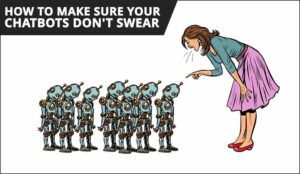Chatbots are reshaping the way businesses interact with their customers, setting new standards for customer experience.
Offering customers instant, personalized support, 24/7 is convenient and efficient, and in today’s customer-centric world, keeping your customers happy is essential.
However, creating a successful chatbot requires a combination of the art of understanding human conversation with the science of programming accurate, helpful responses.
This article will guide you through the key elements that make these interactions effective for your business.
Eight Chatbot Best Practices
1. Disclose AI Interaction
Transparency is the cornerstone of trust, especially regarding customer interactions.
Openly stating that the customer is engaging with an AI chatbot at the beginning of the interaction sets clear expectations and creates an environment of honesty and openness.
This practice can also prevent potential dissatisfaction or frustration from miscommunications or unmet expectations.
2. Help Your Chatbot Understand Customer Queries
A chatbot is only as good as its understanding of customer queries. To design an effective chatbot, analyzing common support questions and studying customer-agent interactions is essential.
This allows you to equip your chatbot with the knowledge and resources to address user needs effectively.
A chatbot that understands and appropriately responds to user queries enhances customer satisfaction and reduces the workload on your human agents.
3. Optimize Workflows
Efficiency is key in customer service, and chatbots play a significant role in streamlining workflows.
Creating workflows that expedite issue resolution ensures customers can resolve inquiries efficiently, improving customer satisfaction and loyalty.
It’s important to strategically create chatbot workflows to guide users toward quick and accurate solutions.
4. Provide Suggested Responses
Providing users with response options is another critical best practice. Offering the choice to click on predefined responses or provide custom inputs enhances user engagement and control over the conversation.
It also helps to steer the conversation in a productive direction, making interactions more efficient and satisfying.
5. Use Clear Language
The language your chatbot uses can significantly impact user understanding and satisfaction. Crafting chatbot responses using clear, simple, and conversational language is crucial.
Avoid complex jargon or technical terms that may confuse users. Friendly, easy-to-understand language makes interactions smooth and enjoyable.
6. Give Customers the Option to Speak to a Human
Regardless of how sophisticated a chatbot is, there will be instances when it can’t adequately address a customer query.
In such cases, it’s critical to have an option for seamless escalation to a human agent. This ensures that customers are not left frustrated or dissatisfied, and their queries are resolved promptly by a capable agent.
7. Personalize the Chatbot Experience
Add personalization elements to make your customers feel valued and recognized. For example, greet your customers by name and provide relevant content or offers.
Personalization can significantly enhance the chatbot user experience. Incorporating personalization elements into chatbot interactions and maintaining conversation context across different communication channels can help create a cohesive and engaging user experience.
8. Train the AI Model
Prioritizing ongoing AI training is vital to improve the accuracy of chatbot responses. Regular training lets your chatbot learn from past interactions, become smarter, and provide more accurate and relevant responses.
This ongoing learning process is essential for improving the quality of chatbot-customer interactions and ensuring ethical standards are upheld.
A tool allows you to easily train your AI models, helping them evolve and improve. Your chatbot can better comprehend customer intent, context, and sentiment, leading to more successful and gratifying customer interactions.
FAQs
How Can a Customer Service Chatbot Enhance Overall Customer Satisfaction?
A customer service chatbot enhances satisfaction by providing instant responses, 24/7 availability, and personalized service.
It can answer frequent queries promptly, reducing waiting times. Also, it can remember past interactions, providing a tailored experience for each customer.
Overall, using chatbots in customer service can lead to happier customers, higher retention rates, and a more efficient customer service experience for businesses.
What Measures Are in Place to Ensure Data Security and Privacy With a Customer Service Chatbot?
Data security and privacy are top priorities with chatbots. Measures include data encryption, strict access controls, and adherence to data protection regulations to protect and safeguard user privacy.
What Are Best Practices for Customer Service Chatbots?
Key best practices include disclosing AI interaction upfront, understanding common customer queries, optimizing workflows, using clear language, offering response options, providing seamless escalation to human agents, incorporating personalization, and ensuring continuous AI training.
How Does the Customer Service Chatbot Handle Complex Queries or Situations Beyond Its Capabilities?
When a chatbot encounters a query or situation it can’t handle, it should seamlessly transfer the conversation to a human agent, to ensure that customers still receive the help they need.
For more information about Talkdesk - visit the Talkdesk Website
Call Centre Helper is not responsible for the content of these guest blog posts. The opinions expressed in this article are those of the author, and do not necessarily reflect those of Call Centre Helper.
Author: Talkdesk
Published On: 5th Mar 2024 - Last modified: 6th Dec 2024
Read more about - Guest Blogs, Talkdesk






 Talkdesk is a global customer experience leader for customer-obsessed companies. Our contact center solution provides a better way for businesses and customers to engage with one another.
Talkdesk is a global customer experience leader for customer-obsessed companies. Our contact center solution provides a better way for businesses and customers to engage with one another. 

































